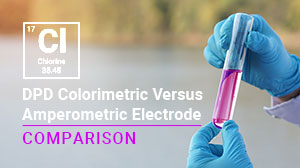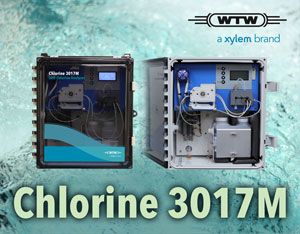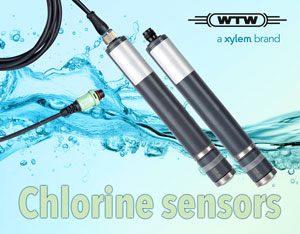2/24/2025
| Dr. Lisa Wild, Nicolas Kaltwasser
Measuring chlorine levels in water is essential for various applications such as swimming pools, industrial processes and drinking water treatment. Two primary methods used are DPD colorimetric and amperometric electrode. Both methods offer accurate results but differ fundamentally in their approach to chlorine determination. This blog post explores the differences between these two methods and discusses their strengths and limitations.
DPD Colorimetric Method
 The DPD (N,N-diethyl-p-phenylenediamine) colorimetric method is widely used for chlorine measurement in various applications, including swimming pools, industrial processes, drinking water and wastewater treatment. It is a colorimetric method that relies on the reaction between chlorine and DPD reagents, which produces a colored compound. The intensity of the color is directly proportional to the chlorine concentration in the water sample. It can be quantified using a spectrophotometer by measuring color intensity or absorbance at a selected wavelength. Both free chlorine and total chlorine can be measured.
The DPD (N,N-diethyl-p-phenylenediamine) colorimetric method is widely used for chlorine measurement in various applications, including swimming pools, industrial processes, drinking water and wastewater treatment. It is a colorimetric method that relies on the reaction between chlorine and DPD reagents, which produces a colored compound. The intensity of the color is directly proportional to the chlorine concentration in the water sample. It can be quantified using a spectrophotometer by measuring color intensity or absorbance at a selected wavelength. Both free chlorine and total chlorine can be measured.
Free chlorine (hypochlorous acid or HOCl and hypochlorite ions or ClO⁻) leads to oxidation of the DPD indicator reagent at a pH value between 6.3 and 6.6 and forms the purple-colored compound. A buffer solution for free chlorine maintains the correct pH value.
Total chlorine (free chlorine and chloramines) is determined by adding potassium iodide to the reaction. Chloramines in the sample cause an oxidation of iodide to iodine, which together with the available free chlorine leads to an oxidation of the DPD indicator reagent at a pH value of 6.5 and 8.5 and forms the purple-colored compound. A buffer solution for total chlorine contains potassium iodide and maintains the correct pH value at the same time.
Procedure
- Collect a water sample in a test cell or cuvette.
- Add DPD reagents to the water sample.
- Mix the reagents thoroughly to ensure complete reaction.
- Allow the color to develop for a specific duration.
- Compare the resulting color intensity with a color scale or use a spectrophotometer to measure the absorbance at a specific wavelength.
- Determine the chlorine concentration based on the color intensity or absorbance value.
Amperometric Electrode Method
The amperometric electrode method is typically used to measure free chlorine levels. HOCl molecules contained in the water differ through a selective membrane and are reduced to chloride ions (Cl-) at the working electrode, typically made of gold. At the counter electrode, typically silver made, chloride ions react with silver to silver chloride. The electrodes generate a current proportional to the chlorine ion concentration. Noval amperometric electrode sensors can also measure total chlorine. Here, free chlorine and chloramines are reduced at the working electrode.
![Effectiveness of Sodium Hypochlorite in the Prevention of Catheter Related Infections - Scientific Figure on ResearchGate. Available from: https://www.researchgate.net/figure/nfluence-of-pH-on-chlorine-hypochlorite-solution-equilibria_fig1_6698813 [accessed 14 Feb 2025]](https://www.researchgate.net/profile/Federico-Nalesso/publication/6698813/figure/fig1/AS:667223131684864@1536089799023/nfluence-of-pH-on-chlorine-hypochlorite-solution-equilibria.png)
Influence of pH on hypochlorid acid (HOCl)1)
With the amperometric electrode methode it is important to know the pH value in the water. The pH value determines the equilibrium of HOCl with Cl2 (low pH values) and ClO⁻ (high pH values) with only HOCl having the desired disinfection function. Therefore, a pH value of 4 to 9 is recommended. When measuring free chlorine in mg/l with the amperometric electrode method the quantitatively contributing amount of ClO⁻ in the water is respected by compensating pH and the respective equilibrium of ClO⁻ and HOCl.
While amperometric sensors may involve a higher initial investment and require periodic calibration and maintenance, their ability to provide real-time data, reduce the need for manual intervention, and operate effectively in automated monitoring systems makes them an essential choice for chlorine measurement in water treatment applications.
Procedure
- Immerse the chlorine-selective electrode and the reference electrode in the water sample.
- Apply a small voltage to the electrodes to establish a constant potential.
- Measure the resulting current generated due to the electrochemical reaction between chlorine and the electrode.
- Calibrate the electrode using known chlorine standards to establish a linear relationship between current and chlorine concentration.
- Determine the chlorine concentration based on the measured current.
Instrumentation
 Xylem’s 3017M DPD Chlorine Analyzer by WTW provides continuous free or total chlorine measurements for applications where the DPD colorimetric method is preferred. This analyzer is designed to streamline the chlorine determination process by automating the colorimetric method, offering significant advantages over traditional manual testing.
Xylem’s 3017M DPD Chlorine Analyzer by WTW provides continuous free or total chlorine measurements for applications where the DPD colorimetric method is preferred. This analyzer is designed to streamline the chlorine determination process by automating the colorimetric method, offering significant advantages over traditional manual testing.
The 3017M simplifies the procedure by automatically mixing the DPD reagents with the water sample and precisely timing the color development. The analyzer then measures the resulting color intensity or absorbance, providing accurate and reliable chlorine concentration values. This automated approach not only enhances efficiency and repeatability but also reduces the potential for human error.
The analyzer is accurate, reliable, and built with advanced flow injection technology, factory calibration, and simplified tubing, which lower reagent use and maintenance requirements. The 3017M is a robust and dependable solution for DPD colorimetric chlorine measurement in various water treatment and quality control applications.
 Xylem’s FCML (free chlorine) and TCML (total chlorine) sensors by WTW offer high sensitivity, making them particularly well-suited for detecting low chlorine concentrations. Moreover, they exhibit minimal interference from colored substances or turbidity in the water, providing accurate and reliable results even in challenging environmental conditions.
Xylem’s FCML (free chlorine) and TCML (total chlorine) sensors by WTW offer high sensitivity, making them particularly well-suited for detecting low chlorine concentrations. Moreover, they exhibit minimal interference from colored substances or turbidity in the water, providing accurate and reliable results even in challenging environmental conditions.
Due to their special design (potentiostatic 3-electrode system), the sensors detect free chlorine (sum of gaseous dissolved chlorine, hypochlorous acid and hypochlorite) as well as chlorine bound to isocyanuric acid. Thereby the sensors are characterized by a greatly reduced pH dependency. The sensors have integrated measurement electronics and provide a temperature-compensated measurement signal. Zero point adjustment is not necessary. Regular calibration is carried out by comparison with the photometric DPD method in accordance with DIN 38408.
Conclusion
Technique
|
DPD (N,N-diethyl-p-phenylenediamine) Colorimetric, Reagent and Analyzer-based |
Amperometric, Electrode-based |
Description
|
The standard measurement method of chlorine. This technique uses reagents and a photometer to measure the amount of free or total chlorine in a sample. |
Designed for process control using two dissimilar electrodes (anode and cathode) to measure the change in current based on a chemical reaction taking place that is proportional to the amount of chlorine in the sample. |
Measurement Range
|
- 0 ... 5 mg/l (free or total chlorine),
depending on reagents
- Threshold 0.03 mg/l
|
Depending on version
- 0.005 …20.00 mg/l (free chlorine)
- 0.01 … 2.00 mg/l (total chlorine)
|
Interferences
|
Iron causes negative interference at all levels. Manganese causes positive interference at all levels. |
Dependent on consistent pH, sample temperature, flow and pressure. Chlorine concentration cannot fluctuate by more than ±20 % or be at zero. |
Maintenance
|
- Replace reagent monthly
- Replace tubing every 6 months
- Cleaning requirement dependent on application
|
- New electrolyte every 6 month
- New membrane every 12 month
- Electrode polishing, if required
|
Calibration
|
- No calibration required. Factory calibrated (only needs calibrated if required by a regulatory agency).
- 1-point calibration adjustment based on a grab sample is possible.
|
- Weekly reference measurement recommended.
- Membrane conditioning and sensor calibration required every 1 to 2 months and after a membrane change
|
Causes of Fouling
|
Air in sample line, biological growth in measurement cell and sample turbidity >100 NTU. |
Iron, manganese and high turbidity can increase calibration and maintenance requirements. |
To the products:

You may also be interested in these blog articles:
If you would like to have this comparison at hand in a compact format, download our TechNote:
 Comparing Chlorine Measurement Methods
Comparing Chlorine Measurement Methods
Colorimetric DPD Analyzer vs. Amperometric Electrode
References:
- Effectiveness of Sodium Hypochlorite in the Prevention of Catheter Related Infections - Scientific Figure on ResearchGate. Available from: https://www.researchgate.net/figure/nfluence-of-pH-on-chlorine-hypochlorite-solution-equilibria_fig1_6698813 ; accessed Feb 14, 2025